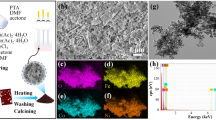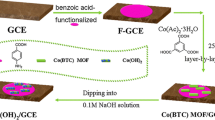Abstract
Copper-based metal–organic frameworks (MOF) and multi-walled carbon nanotubes (HKUST-1-MWCNTs) composite were synthesized by one-step hydrothermal method, and PDA-enzyme-HKUST-1-MWCNTs composite was prepared by one-pot method for the construction of glucose biosensors, which realized the sensitive amperometric detection of glucose at 0.7 V (vs. SCE). The sensitivity of the sensor for glucose detection was 178 μA mM−1cm−2 in the wide linear range of 0.005 ~ 7.05 mM, the detection limit was 0.12 μM and the corresponding RSD was 3.8%. Its high performance is mainly benefitted from the high porosity and large specific surface area of HKUST-1, the good conductivity of MWCNTs, and the excellent adhesion and dispersion of PDA. The strategy of combining PDA and MWCNTs to improve the dispersion and conductivity of MOF is expected to achieve a wider application of MOF-based materials in the electrochemical biosensing field.
Graphical Abstract







Similar content being viewed by others
References
Zhu QL, Xu Q (2014) Metal-organic framework composites. Chem Soc Rev 43:5468–5512. https://doi.org/10.1039/c3cs60472a
Yuan S, Feng L, Wang KC, Pang JD, Bosch M, Lollar C, Sun YJ, Qin JS, Yang XY, Zhang P, Wang Q, Zou LF, Zhang YM, Zhang LL, Fang Y, Li JL, Zhou HC (2018) Stable metal-organic frameworks: design, synthesis, and applications. Adv Mater 30:1–35. https://doi.org/10.1002/adma.201704303
Cui YJ, Li B, He HJ, Zhou W, Chen BL, Qian GD (2016) Metal-organic frameworks as platforms for functional materials. Acc Chem Res 49:483–493. https://doi.org/10.1021/acs.accounts.5b00530
Xia W, Mahmood A, Zou RQ, Xu Q (2015) Metal-organic frameworks and their derived nanostructures for electrochemical energy storage and conversion. Energy Environ Sci 8:1837–1866. https://doi.org/10.1039/c5ee00762c
Farha OK, Hupp JT (2010) Rational design, synthesis, purification, and activation of metal-organic framework materials. Acc Chem Res 43:1166–1175. https://doi.org/10.1021/ar1000617
Howarth AJ, Liu YY, Li P, Li ZY, Wang TC, Hupp J, Farha OK (2016) Chemical, thermal and mechanical stabilities of metal-organic frameworks. Nat Rev Mater 1:1–15. https://doi.org/10.1038/natrevmats.2015.18
Anik U, Timur S, Dursun Z (2019) Metal organic frameworks in electrochemical and optical sensing platforms: a review. Microchimica Acta 186: https://doi.org/10.1007/s00604-019-3321-0
Liang K, Ricco R, Doherty CM, Styles MJ, Bell S, Kirby N, Mudie S, Haylock D, Hill AJ, Doonan CJ, Falcaro P (2015) Biomimetic mineralization of metal-organic frameworks as protective coatings for biomacromolecules. Nat Commun 6:1–8. https://doi.org/10.1038/ncomms8240
Zhang ZH, Duan FH, Tian JY, He JY, Yang LY, Zhao H, Zhang S, Liu CS, He LH, Chen M, Chen DM, Du M (2017) Aptamer-embedded zirconium-based metal-organic framework composites prepared by de novo bio-inspired approach with enhanced biosensing for detecting trace analytes. Acs Sensors 2:982–989. https://doi.org/10.1021/acssensors.7b00236
Lian XZ, Fang Y, Joseph E, Wang Q, Li JL, Banerjee S, Lollar C, Wang X, Zhou HC (2017) Enzyme-MOF (metal-organic framework) composites. Chem Soc Rev 46:3386–3401. https://doi.org/10.1039/c7cs00058h
Liang WB, Wied P, Carraro F, Sumby CJ, Nidetzky B, Tsung CK, Falcaro P, Doonan CJ (2021) Metal-organic framework-based enzyme biocomposites. Chem Rev 121:1077–1129. https://doi.org/10.1021/acs.chemrev.0c01029
Wu EH, Li YX, Huang Q, Yang ZK, Wei AY, Hu Q (2019) Laccase immobilization on amino-functionalized magnetic metal organic framework for phenolic compound removal. Chemosphere 233:327–335. https://doi.org/10.1016/j.chemosphere.2019.05.150
Chui Lo, Charmant O W (1999) A chemically functionalizable nanoporous material. Science (New York, NY) 283:1148–1150. https://doi.org/10.1126/science.283.5405.1148
Nam DH, Bushuyev OS, Li J, De Luna P, Seifitokaldani A, Dinh CT, de Arquer FPG, Wang YH, Liang ZQ, Proppe AH, Tan CS, Todorovic P, Shekhah O, Gabardo CM, Jo JW, Choi JM, Choi MJ, Baek SW, Kim J, Sinton D, Kelley SO, Eddaoudi M, Sargent EH (2018) Metal-organic frameworks mediate Cu coordination for selective CO2 electroreduction. J Am Chem Soc 140:11378–11386. https://doi.org/10.1021/jacs.8b06407
Loera-Serna S, Oliver-Tolentino MA, Lopez-Nunez MD, Santana-Cruz A, Guzman-Vargas A, Cabrera-Sierra R, Beltran HI, Flores J (2012) Electrochemical behavior of Cu-3(BTC)(2) metal-organic framework: the effect of the method of synthesis. J Alloy Compd 540:113–120. https://doi.org/10.1016/j.jallcom.2012.06.030
Dong SY, Suo GC, Li N, Chen Z, Peng L, Fu YL, Yang Q, Huang TL (2016) A simple strategy to fabricate high sensitive 2,4-dichlorophenol electrochemical sensor based on metal organic framework Cu-3(BTC)(2). Sensors and Actuators B-Chemical 222:972–979. https://doi.org/10.1016/j.snb.2015.09.035
Luo FQ, Lin YL, Zheng LY, Lin XM, Chi YW (2015) Encapsulation of hemin in metal organic frameworks for catalyzing the chemiluminescence reaction of the H2O2-luminol system and detecting glucose in the neutral condition. ACS Appl Mater Interfaces 7:11322–11329. https://doi.org/10.1021/acsami.5b01706
Tan HL, Li Q, Zhou ZC, Ma CJ, Song YH, Xu FG, Wang L (2015) A sensitive fluorescent assay for thiamine based on metal-organic frameworks with intrinsic peroxidase-like activity. Anal Chim Acta 856:90–95. https://doi.org/10.1016/j.aca.2014.11.026
Tiwari JN, Vij V, Kemp KC, Kim KS (2016) Engineered carbon-nanomaterial-based electrochemical sensors for biomolecules. ACS Nano 10:46–80. https://doi.org/10.1021/acsnano.5b05690
Wang J (2005) Carbon-nanotube based electrochemical biosensors: a review. Electroanalysis 17:7–14. https://doi.org/10.1002/elan.200403113
Lee H, Dellatore SM, Miller WM, Messersmith PB (2007) Mussel-inspired surface chemistry for multifunctional coatings. Science 318:426–430. https://doi.org/10.1126/science.1147241
Ye Q, Zhou F, Liu WM (2011) Bioinspired catecholic chemistry for surface modification. Chem Soc Rev 40:4244–4258. https://doi.org/10.1039/c1cs15026j
Yao JY, Wu TT, Sun Y, Ma ZY, Liu ML, Zhang YY, Yao SZ (2019) A novel biomimetic nanoenzyme based on ferrocene derivative polymer NPs coated with polydopamine. Talanta 195:265–271. https://doi.org/10.1016/j.talanta.2018.11.069
Yang HL, Xu WT, Liang XY, Yang YY, Zhou Y (2020) Carbon nanotubes in electrochemical, colorimetric, and fluorimetric immunosensors and immunoassays: a review. Microchimica Acta 187: https://doi.org/10.1007/s00604-020-4172-4
Pastucha M, Farka Z, Lacina K, Mikusova Z, Skladal P (2019) Magnetic nanoparticles for smart electrochemical immunoassays: a review on recent developments. Microchimica Acta 186: https://doi.org/10.1007/s00604-019-3410-0
Li YQ, Li YZ, Yu XL, Sun Y (2019) Electrochemical determination of carbofuran in tomatoes by a concanavalin A (Con A) polydopamine (PDA)-Reduced graphene oxide (RGO)-gold nanoparticle (GNP) glassy carbon electrode (GCE) with immobilized acetylcholinesterase (AChE). Anal Lett 52:2283–2299. https://doi.org/10.1080/00032719.2019.1609490
Chen C, Wang LH, Tan YM, Qin C, Xie FY, Fu YC, Xie QJ, Chen JH, Yao SZ (2011) High-performance amperometric biosensors and biofuel cell based on chitosan-strengthened cast thin films of chemically synthesized catecholamine polymers with glucose oxidase effectively entrapped. Biosens Bioelectron 26:2311–2316. https://doi.org/10.1016/j.bios.2010.09.058
Lin KS, Adhikari AK, Ku CN, Chiang CL, Kuo H (2012) Synthesis and characterization of porous HKUST-1 metal organic frameworks for hydrogen storage. Int J Hydrogen Energy 37:13865–13871. https://doi.org/10.1016/j.ijhydene.2012.04.105
Mao YY, Su BB, Cao W, Li JW, Ying YL, Ying W, Hou YJ, Sun LW, Peng XS (2014) Specific oriented metal-organic framework membranes and their facet-tuned separation performance. ACS Appl Mater Interfaces 6:15676–15685. https://doi.org/10.1021/am5049702
Abdulla S, Mathew TL, Pullithadathil B (2015) Highly sensitive, room temperature gas sensor based on polyaniline-multiwalled carbon nanotubes (PANI/MWCNTs) nanocomposite for trace-level ammonia detection. Sensors Actuators B-Chem 221:1523–1534. https://doi.org/10.1016/j.snb.2015.08.002
Yan LJ, Bo XJ, Zhu DX, Guo LP (2014) Well-dispersed Pt nanoparticles on polydopamine-coated ordered mesoporous carbons and their electrocatalytic application. Talanta 120:304–311. https://doi.org/10.1016/j.talanta.2013.12.031
Dong SY, Zhang DD, Suo GC, Wei WB, Huang TL (2016) Exploiting multi-function metal-organic framework nanocomposite Ag@Zn-TSA as highly efficient immobilization matrixes for sensitive electrochemical biosensing. Anal Chim Acta 934:203–211. https://doi.org/10.1016/j.aca.2016.05.040
Hou C, Wang Y, Ding QH, Jiang L, Li M, Zhu WW, Pan D, Zhu H, Liu MZ (2015) Facile synthesis of enzyme-embedded magnetic metal-organic frameworks as a reusable mimic multi-enzyme system: mimetic peroxidase properties and colorimetric sensor. Nanoscale 7:18770–18779. https://doi.org/10.1039/c5nr04994f
Liu X, Qi W, Wang YF, Su RX, He ZM (2017) A facile strategy for enzyme immobilization with highly stable hierarchically porous metal-organic frameworks. Nanoscale 9:17561–17570. https://doi.org/10.1039/c7nr06019j
Dai MZ, Huang T, Chao L, Tan YM, Chen C, Meng WH, Xie QJ (2016) Tyrosinase-catalyzed polymerization of L-DOPA (versus L-tyrosine and dopamine) to generate melanin-like biomaterials for immobilization of enzymes and amperometric biosensing. RSC Adv 6:17016–17022. https://doi.org/10.1039/c5ra27478h
Chen KJ, Lee CF, Rick J, Wang SH, Liu CC, Hwang BJ (2012) Fabrication and application of amperometric glucose biosensor based on a novel PtPd bimetallic nanoparticle decorated multi-walled carbon nanotube catalyst. Biosens Bioelectron 33:75–81. https://doi.org/10.1016/j.bios.2011.12.020
Patra S, Crespo TH, Permyakova A, Sicard C, Serre C, Chausse A, Steunou N, Legrand L (2015) Design of metal organic framework-enzyme based bioelectrodes as a novel and highly sensitive biosensing platform. J Mater Chem B 3:8983–8992. https://doi.org/10.1039/c5tb01412c
Funding
This work was supported by the National Natural Science Foundation of China (21405042, 21175042), the Open Fund of Key Laboratory of Jiangxi Province for Persistent Pollutants Control and Resources Recycle (Nanchang Hangkong University), the Open Fund of State Key Laboratory of Chemo/Biosensing and Chemometrics (Hunan Normal University), the Open Fund of Large-scale Instrument and Equipment (Hunan Normal University) (19CSY004), and A Project Supported by Scientific Research Fund of Hunan Provincial Education Department (2016SK2020).
Human serum and urine samples based procedures were undertaken in accordance with the Guidelines for Care and Use of Laboratory Animals, and were approved by the Biomedical Research Ethics Committee of Hunan Normal University. Informed consents were obtained from human participants of this study.
Author information
Authors and Affiliations
Corresponding author
Ethics declarations
Conflict of interest
The authors declare that they have no competing interests.
Additional information
Publisher's note
Springer Nature remains neutral with regard to jurisdictional claims in published maps and institutional affiliations.
Supplementary Information
Below is the link to the electronic supplementary material.
Rights and permissions
Springer Nature or its licensor (e.g. a society or other partner) holds exclusive rights to this article under a publishing agreement with the author(s) or other rightsholder(s); author self-archiving of the accepted manuscript version of this article is solely governed by the terms of such publishing agreement and applicable law.
About this article
Cite this article
Chen, C., Xu, H., Zhan, Q. et al. Preparation of novel HKUST-1-glucose oxidase composites and their application in biosensing. Microchim Acta 190, 10 (2023). https://doi.org/10.1007/s00604-022-05563-4
Received:
Accepted:
Published:
DOI: https://doi.org/10.1007/s00604-022-05563-4




